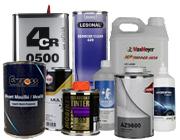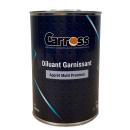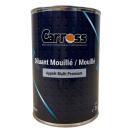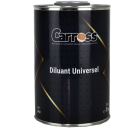Carross Thinners and Additives

Carross professional paint thinners
-
 AMPDIG1Thinner for multi-purpose primerFiller 1L
AMPDIG1Thinner for multi-purpose primerFiller 1L -
 AMPDIMThinner for multi-purpose primerWet / Wet 1L
AMPDIMThinner for multi-purpose primerWet / Wet 1L -
 DIU12K acrylic ThinnerUniversal 1L
DIU12K acrylic ThinnerUniversal 1L
︾
Paint Thinners and Bodywork Additives: a presentation of the benefits
In the automotive bodywork sector, paint thinners and additives play a crucial role in the painting and finishing process. Here are some of the key benefits of using Thinners and Additives in this context:
1. Paint thinning :
Paint Thinners are used to adjust the viscosity of the paint, making it easier to apply to the body surface. Paint that is too thick can lead to problems such as unevenness, drips or bubbles, while paint that is too runny may not adhere properly.
2. Drying time :
Some Paint Thinners can speed up the paint drying process. This reduces the Flash-off between layers of paint, which is particularly important in a professional environment where efficiency is crucial.
3. Improved adhesion :
Certain Additives are designed to improve the adhesion of the paint to the body surface. This ensures a durable finish that is resistant to weathering, scratches and other forms of wear.
4. Gloss control :
Certain Additives allow the gloss level of the Paint to be regulated. This offers flexibility to bodywork professionals and vehicle owners who wish to personalise the final appearance of their car.
5. Reducing imperfections :
Certain additives help to minimise imperfections, such as spray lines, bubbles or finger marks, creating a more aesthetically pleasing finish.
6. Corrosion protection:
Certain Additives can be added to the Paint to provide additional corrosion protection. This is particularly important to preserve the durability of the bodywork and keep it in good condition over time.
7. Repairing touch-ups :
Paint thinners and additives also make it easier to touch up and repair minor paint damage without compromising the consistency of the overall finish.
It is important to note that the correct use of Paint Thinners and Additives requires a thorough understanding of the properties of the paint, the environmental conditions and the specifics of the paint job in hand. Incorrect use of these products can have negative consequences on the quality of the finish and the durability of the paint.
Application and use of Thinner and Additive:
The application of Paint Thinner and Additives in the field of car bodywork depends on the specific product you are using and the result you are looking for. However, here are some general steps to follow when applying these products to a car's surface:
1. Prepare the surface:
Make sure the car's surface is clean, dry and free from any residue of dirt, wax or grease. If necessary, clean the surface with a suitable Degreaser.
2. Product selection :
Choose the paint Thinner and Additives according to the specifications of the paint you are using and the results you want to achieve. Carefully follow the manufacturer's instructions for proportions and application methods.
3. Measure accurately :
Accurately measure the required amount of Thinner or Additive according to the manufacturer's recommendations. The correct proportions are essential to obtain the desired results.
4. Mixing:
Thoroughly mix the Thinner or Additive with the Paint. Use a suitable agitator or paint mixer to ensure even distribution.
5. Viscosity test:
Perform a viscosity test to ensure the paint is at the desired consistency. If necessary, adjust the amount of Paint Thinner to achieve the correct viscosity.
6. Applying the paint :
Apply the paint to the body surface using the spray, roller or brush method, depending on your preference and the requirements of the job. Be sure to apply the paint evenly.
7. Drying:
Follow the drying times recommended by the manufacturer. Some Paint Thinners can speed up the drying process, but it is essential to follow the instructions to avoid any problems later on.
8. Finishing:
If necessary, apply specific additives to achieve the desired finish in terms of gloss, scratch resistance, etc.
9. Cleaning tools :
Thoroughly clean tools, brushes, spray guns, etc., used in the process, following the manufacturer's recommendations for appropriate solvents.
It is important to note that procedures may vary depending on the specific products you are using. Always consult the manufacturer's instructions on the packaging of Thinner, Additives and Paint for precise information on their use and application.
The different types of paint thinner for car and motorbike bodywork:
Primer Thinners and 2K acrylic Paint Thinners are chemicals used in the automotive paint process. Here is specific information on each of these types of Thinner:
Paint Thinner for Primer :
Purpose : Paint Thinner for Primer is used to adjust the viscosity of the primer, which is a Basecoat applied prior to final painting. The aim is to obtain an appropriate consistency for uniform application of the primer to the bodywork surface.
Viscosity : Primers sometimes have a thicker consistency, and Thinner for Primer helps to make them more fluid, making them easier to apply using a spray gun.
Surface preparation: Paint Thinner for Primer helps to achieve a smooth, even surface by ensuring that the primer can be applied evenly, reducing the risk of unevenness or runs.
2K acrylic Paint Thinner :
2K Characteristics: '2K' indicates that the paint is two-component, meaning that it requires a Hardener to achieve its full strength and durability. Thinner for 2K acrylic paint is designed specifically for use with two-component paints.
Viscosity adjustment: As with Primer Thinner, 2K Acrylic Paint Thinner is used to adjust the viscosity of the paint, allowing for easier application and a more uniform finish.
Risk reduction : By using the right Paint Thinner, bodywork professionals can reduce the risk of problems such as spray marks, bubbles or uneven drying.
Respect for ratios : It is essential to respect the manufacturer's recommended ratios for mixing 2K acrylic paint, Hardener and Thinner, as this affects the quality of the finish and the durability of the coating.
It is crucial to follow the specific instructions of the manufacturer of the paint, primer, Thinner and Hardener you are using, as formulations can vary from brand to brand. Failure to follow the manufacturer's recommendations can lead to problems with paint performance, adhesion and durability.
Use Thinner and Additive correctly:
The use of Paint Thinners often raises a large number of questions among users, particularly in the field of car bodywork. Here is an overview of the most frequently asked questions and their corresponding answers:
What is Thinner Paint used for in the bodywork process?
Thinner is used to adjust the viscosity of the paint, making it easier to apply to the bodywork surface. It also helps the paint to dry properly.
What's the difference between paint thinner for primers and 2K acrylic paint thinner?
Primer paint thinner is specifically designed to adjust the viscosity of primer, while 2K acrylic paint thinner is used with two-component paints to adjust viscosity and facilitate application.
How do I choose the right Thinner for my Paint?
The choice of Thinner for Paint depends on the type of paint used. It is essential to consult the paint manufacturer's recommendations to find the right Thinner and to respect the Mixing ratios.
Can I use any paint thinner with any paint?
No, it's vital to use the paint thinner recommended by the paint manufacturer. Using the wrong Thinner can affect the quality of the finish, the adhesion and the durability of the paint.
What are the risks of using paint thinners incorrectly?
Incorrect use of Paint Thinners can lead to problems such as drips, uneven drying, poor adhesion and even damage to the bodywork surface.
Do I need to thin the paint with each coat?
Not necessarily. Thinning depends on various factors such as the viscosity of the original paint, environmental conditions and the type of application. Follow the manufacturer's recommendations.
Can I use Paint Thinner as a cleaner for painting tools?
Yes, but use the appropriate solvent for the type of paint you're using. Be sure to clean tools thoroughly after each use.
How can I avoid problems when using Thinner Paint?
Strictly follow the manufacturer's instructions, measure quantities accurately, carry out viscosity tests and make sure you use the recommended Thinner Paint to avoid potential problems.
In short, a thorough understanding of the specifics of paint thinners and their correct use is essential to ensure a high quality, long-lasting bodywork finish. It is advisable to consult the manufacturer's instructions for each product used and to follow industry best practice.